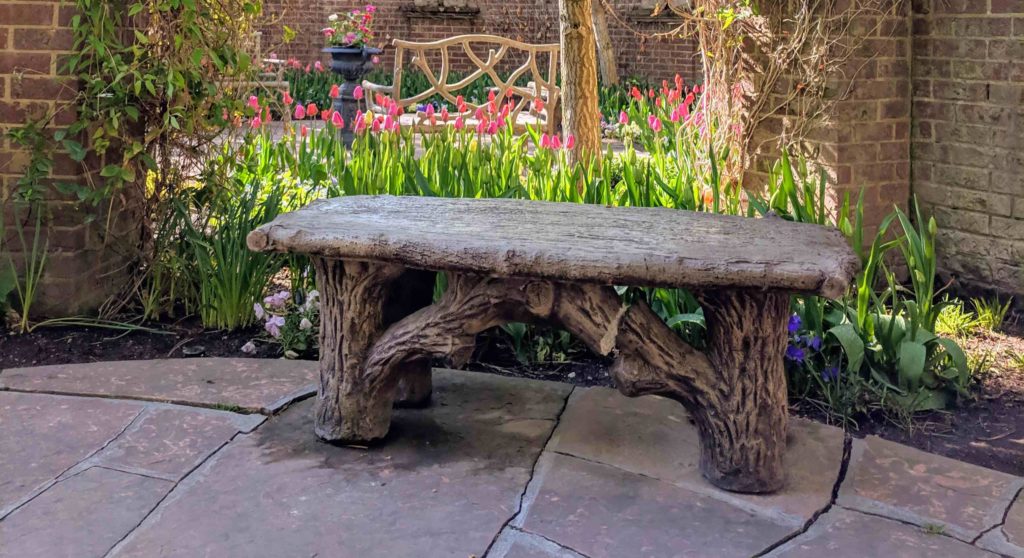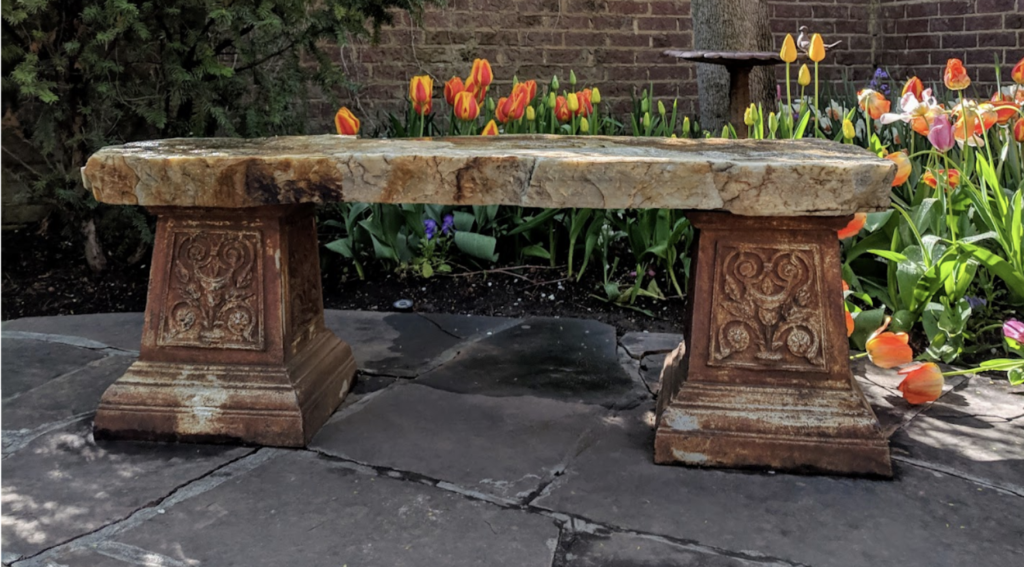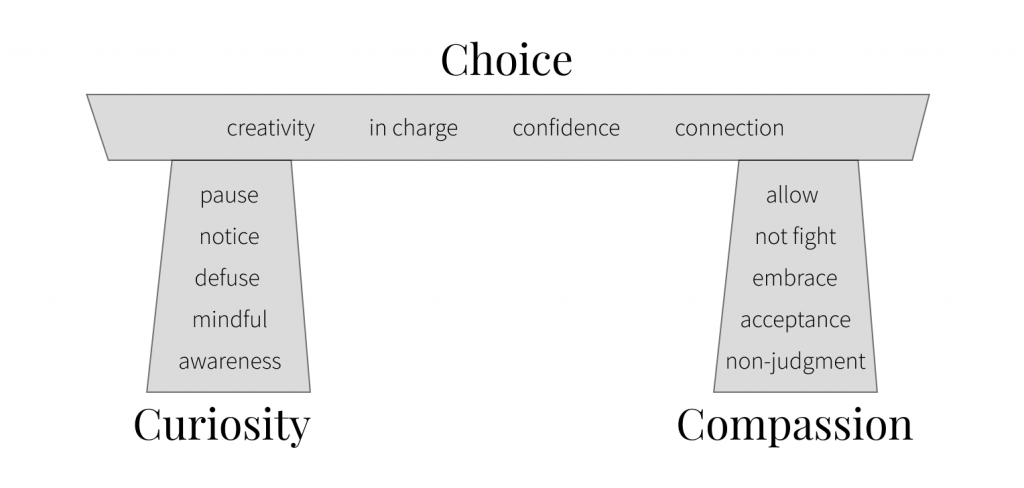Thanks—Here's your free download!
No time to download? Read the mindfulness guide below.
On your mobile device? Read the mindfulness guide below.
A Practical Introduction To Mindfulness: The Mindfulness Bench
How mindfulness places you back in charge of your life, gives you choices, and restores your ability to exercise creativity in problem solving.

Intro
Mindfulness is simply taking a moment to be aware of life—to be mindful of yourself and your surroundings. For example, imagine yourself in the garden on a park bench. Stop and sit for a while. Take a deep breath and notice what is happening in your mind and body and emotions.
A park bench can be a symbol of peace and rest. A place where you can ride out any difficult thoughts and emotions. You can sit on the bench in the middle of a wild storm and be steady, allowing you to sit with your discomfort.
You can do this metaphorically any time you want. Just pause and sit on the bench in your mind. Imagine yourself here with the sun streaming through the trees and flowers blooming and the breeze blowing. Nothing is pressing, nothing is more important than this present moment. Mindfulness IS just THIS moment, right now. Let go of thinking of the future or past.

The Mindfulness Bench Metaphor
When you get flooded with strong emotions, or feel that fight/flight adrenaline, you can stop and sit on the bench in your mind, and be mindful by using two powerful tools: curiosity and compassion.
Curiosity and compassion are the foundational legs of the mindfulness bench. When both are present, you regain balance and are able to think more clearly. You make better choices because you restore creativity in problem solving and find new ways to look at the situation.
Choice is the bench seat, where your confidence grows each time you stop to sit and breathe deeply. As you practice thinking creatively, you start feeling more in control. You are now in charge.

Mindfulness Tool: Curiosity
While you are here on the bench, get curious about what is really happening and what you might be making it mean. You’re becoming mindful, aware and really noticing what IS. Pausing lowers the stress response. To be curious is to notice or become aware. Genuine non judgmental curiosity allows you to pause, to step out of auto-pilot. It helps defuse powerful emotions by looking at the thoughts that precede them.
Connect with what is happening in your body. Become aware of physical symptoms and automatic/current thoughts. Pause to label feelings, describe sensations, identify thoughts, and notice your surroundings.
What Curiosity Sounds Like
You might hear yourself saying things like:
- “I’m feeling tightness, nausea, headache, etc.” (noting, describing)
- “I notice I’m very worried (stressed, concerned, etc.) about this thing.”
- “Wow, I’m flooded with emotions right now.”
- “I’m experiencing flight/flight adrenaline.”
- “I’m stopping to feel so I can choose what to do.”
- “I’m feeling a wave of energy flowing through my body.”
- “I’m an observer, not a victim of this energy.”
- “This is not a problem, just energy to watch/feel.”
- “I’m stopping to watch the show.”
Mindfulness Tool: Compassion
Have some compassion for yourself while you experience whatever is happening. High-five yourself for having stopped and sat on the bench to get curious. Doing so allows you to pause and to simply allow and embrace whatever is happening in the moment. The ability to simply accept as a circumstance that you are feeling powerful emotions is incredibly powerful. If you choose to fight or deny or reject the circumstance, this ironically puts your runaway feelings in control. By compassionately considering the situation you can stop feeling out of control.
What self-compassion sounds like:
- “I’m in charge of my anxiety. It can visit anytime, but I’m in charge.”
- “I might feel (sick, pain, stress) but this is temporary, and I will survive. I am safe.”
- “I’m a person feeling anxiety and that’s OK.”
- “There is nothing wrong with me.” (don’t call it “my” anxiety if that makes it feel like you have a problem. It’s yours if it’s just part of the feelings you feel.)
- “I love and accept the anxiety part of me.”
- “I can have butterflies in my stomach today and that’s OK.”
- “Anxiety, you are welcome to stay, you’re my friend, my superpower.”
- “I feel anxious/worried/stressed and that’s OK.”
- “I’m willing to allow myself time and space to feel this.”
- “I can ride these feelings like a wave, bobbing up and down as the come and go.”
- “This is just adrenaline moving through my body.”
- “This is temporary.”
- “I am having sad and disturbing thoughts, but they are not me.”
- “These are just sentences in my brain.”
Being Willing To Feel
The hallmark of emotional health (and courage!) is to be willing to fully feel any emotion that comes our way. Doing so requires you to use both tools, curiosity and compassion, in tandem.
Start with being fully willing to feel and experience a full-blown anxiety attack. Watch it approach, feel the storm gather. Observe the stress and nausea flood your body. Make note of the tension. Curiously observe without fighting or resisting the storm as it rages. (This will probably be fairly difficult for a while.) You can learn to ride the wave of emotion, becoming a curious witness to anxiety, rather than a victim of anxiety.

Resistance Is Futile
Resisting an overpowering feeling is a futile endeavor. You’ve probably learned this repeatedly. Feelings can be temporarily tamped down, rejected, ignored, etc., but they ultimately cannot be stopped. Trying holding a beach ball deep underwater and eventually it’s going to come flying up with incredible force. It’s like water coming out of a hose—covering the hose with your thumb just results in a stronger stream of water, and potentially wet bystanders.

Overpowering feelings (such as anxiety, anger, or depression) will come. They will always come. Attempting to resist them causes tension and stress to build up to create a stronger stream of feelings that can escape at inopportune times. Instead of fighting the feelings, simply watch the stream go by. Let it go. It will pass. Use your curiosity to observe its coming and going.
What resistance sounds like
Trying to force a state of calm is resistance. It might sound like:
- “I don’t have time for this problem/anxiety right now!”
- “I always have a panic attack before a big (trip, test, reunion, holiday). This time I’ll fight it!”
- “There’s something wrong with me. My anxiety is killing me.” (don’t call it “my” anxiety if that makes it feel like you have a problem.)
- “I can’t deal with this right now!”
- “Why am I the ONLY one who deals with this!?!”
- “I’m fighting this problem/anxiety”
Curiosity + Compassion
Curiosity means not resisting feelings, and a big part of not resisting your feelings is coming to accept them, and to appreciate the value in what the feelings bring with them. This acceptance is self-compassion. Time to start loving!
For example, anxiety is a feeling many want to fight against. However, when viewed with compassion, you’ll recognize that it can be BOTH a kryptonite, AND the source of our superpowers. On the superpower side, Anxiety gives those who are intimately familiar with it an enviable ability to love and show concern. Anxiety helps us to be dependable, reliable, and trustworthy. It helps you form tight and loving bonds with others. These are parts of who you are that are wonderful and admirable.
Embrace this part of you. Welcome it. Love and accept this part of yourself and make peace with yourself and who you are with anxiety/emotions. The more you fight, the higher chance of getting flooded with overpowering emotions.
Making It Yours
Noticing and Allowing puts you back in the place where you can CHOOSE what to do. That is when you get your agency back, or when you truly own your agency. It feels SO good to feel like you have a choice! You don’t have to feel out of control.

Look at the words written on bench above and choose the words that resonate with you personally. Spend time thinking and writing about how those words can be the key to pulling yourself out of the stress response, solve problems or manage issues like anxiety.
Making the Bench personal
Go back through this article and look for phrases that you can write down and try when sitting on your bench. Ask yourself:
- What does defuse or notice mean to me?
- What about embrace or allow?
- How can I stop fighting the current emotion, problem or situation?
- What am I noticing while sitting on the bench? In my body? Thoughts? Around me?
- How can I exercise non-judgment in this current situation?
- How can I embrace this ? What is good about it?
- How can I become aware or mindful of what is happening?
In my coaching work, I help people just like you restore their ability to make healthy choices, to approach life’s challenges with a curious mindset, to think compassionately about their circumstances, to embrace their whole self, and to ultimately find peace and happiness.
I would love to talk with you about coaching and see if it is a good fit for you. Schedule a time for a FREE consultation. Have a question? Shoot me an email at info@jillfreestone.com. I’d love to hear from you.
